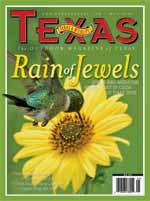
Parakeet Proliferation
Thanks to steady population growth, monk parakeets are making appearances at new sites across the state.
By Betsy Simnacher
When Larry Sall, president of Audubon Dallas, wants to impress foreign visitors with the birds of the area, he takes them to White Rock Lake to see parakeets. “It’s fun when visitors from Europe come to see me, because they know I’m a birdwatcher, and I’ve infected some of them with the same insanity,” he says. “They want to see something interesting, so I take them over there where they can see parakeets, and they find that absolutely fascinating. That’s always fun.”
Monk parakeets, which nest in various places throughout the state, are definitely out of their natural element. They are South American natives, brought here for the pet trade. Some were released, some no doubt escaped, and some flew out of damaged packing crates as they were being shipped in.
“Parakeets are long-lived organisms, and so, I think people just get tired of having them, and they don’t know what to do with them, and so they let them go,” says Texas Parks and Wildlife Conservation Biologist Mark Lockwood, who is also the secretary of the Bird Records Committee of the Texas Ornithological Society. In addition, monk parakeets are one of the least expensive birds available in pet stores, so they’re readily available, he says. Perhaps people more readily let them go than they would a more expensive bird, says Lockwood. Monk parakeet nests have been spotted in at least eight Texas counties, including locations in Dallas, Fort Worth, Temple, Austin, Houston, San Antonio and El Paso. Additional sightings come from the Panhandle as well as East and South Texas.
Whether they were set free or escaped, parakeets in Texas do seem to thrive, despite cold winter weather. (They also live in Chicago, so Dallas weather isn’t a problem.) They build large, permanent nests of sticks that help keep them warm during cold weather. Plus, Texas weather isn’t that different from their native clime, Lockwood says. Unfortunately, they have a decided preference for building nests in the power grid, which has pitted bird lovers against utility workers in other states.
Monk parakeets possibly got their name from their appearance. They are a bright lime green, except for a gray face and chest, which, with a lively imagination, makes them look like monks. They are also called Quaker parakeets. They eat seeds, leaf buds, fruits, berries, nuts and blossoms, according to The Birds of North America by Mark F. Spreyer and Enrique H. Bucher. And they are becoming more numerous, according to steadily growing national figures compiled in the National Audubon Society’s Christmas bird counts. In fact, the society’s winter 2001/2002 bird count data cited a study that showed the U.S. monk parakeet population is doubling every 4.8 years.

